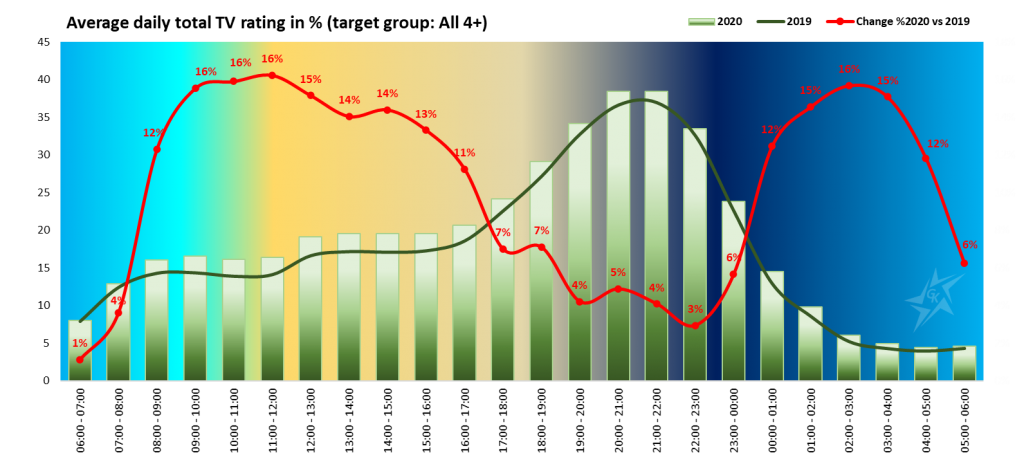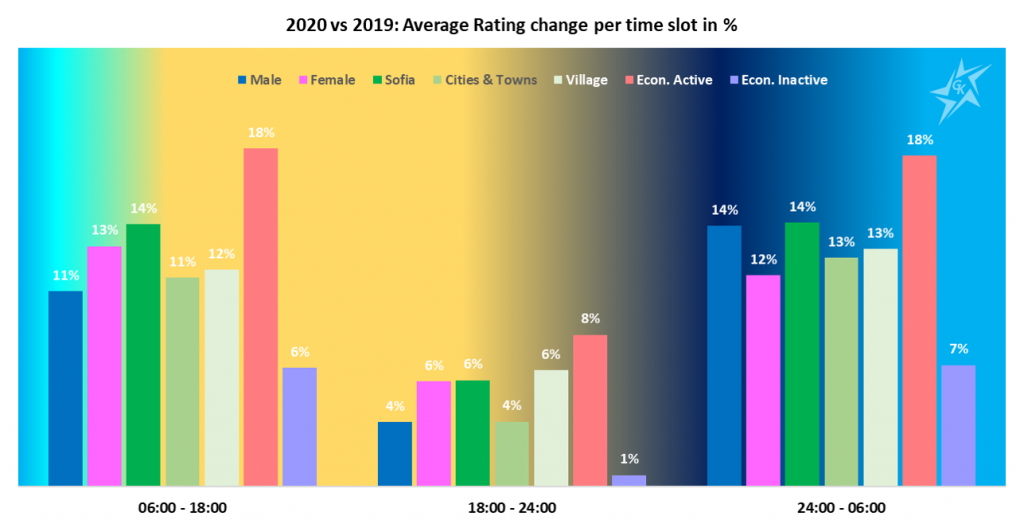In the previous article, our team presented in detail the change in the time we spend in front of TV during the various stages of isolation on weekly basis. The main conclusion we have reached is that television is becoming an increasingly common choice for entertainment by people. The average daily time that the entire population of the country at age 4+ spends on watching TV in 2020 increases by 9% or above 22 minutes compared to 2019.
In this article, we answer the question of how this “extra” time for television is distributed during different day parts. To reach it, we compared the rating data in the target group All 4+ by hours in average for 2019 and for 2020:

The chart shows that all time zones in 2020 report a higher rating compared to 2019. The normal dynamic day of workers and students begins in the early hours of the day, when the first information blocks of the leading televisions start. This trend has changed in the past year. The serious increase in viewership starts at 8 o’clock in the morning and continues throughout the day. This is completely logical, given that isolation has left us at home and leads to higher levels of television watching during the hours we are traditionally out of home. The rating of the television program during the active part of the day between 6 a.m. and 6 p.m. increases by 12%. In the prime-time slot, the hours between 6 p.m. and midnight, this percentage drops to 5%, but it remains the most watched time, respectively with the highest rating. High growth is marked in the hours after midnight, in which people continue to find interesting content to watch. The reported data show that the average rating grows by an average of 13% between midnight and 6 a.m. The explanation of this is the different rhythm that follows the daily life of people in isolation. The distance from the outside world and the long stay at home make us merge the hours of work and rest and sharpen our desire to be constantly “involved” for the changes taking place outside.
The pandemic, the limited opportunities for entertainment outside the home and the work from home lead not only to a longer stay in front of TV, but also to more people, who spend their time in front of TV screens. To track the extent to which television wins different target groups at different day parts, we present to your attention the following chart:

We analyzed the audiences by main characteristics such as gender, type of settlement and economic activity. To understand the change in TV consumption in different parts of the day, we compared the rating achieved by each group in the specific time slot in 2020 vs 2019.
As it has already become clear, the daytime zone marks a high increase in viewership, especially among the people who are kept at home by the pandemic – the economically active part of the population. This circumstance strongly affects the people living in the capital and to a lesser extent those living in the countryside.
The TV program during the daytime is considered more interesting by the female audience, where the achieved rating grows by 13%.
The hours in prime-time, between 6 p.m. and midnight, traditionally enjoy the highest rating among the audience. Also, in this time zone the results in the group of the economically active have the highest growth – 8%. The tendency is kept for the people from Sofia, but also for the audience from the villages, who find more interesting content in prime-time in 2020 compared to 2019. The shows in this time zone turn out to be more liked by the ladies than the men.
The small hours of the day are often overlooked because people are already saturated by information content. In 2020, this statement is questioned by the figures, which show high increase of the rating in the hours after midnight. The group of the economically active population achieves the highest results, in contrast to the economically inactive, whose rating is also growing, but within more moderate range. The imposed isolation has the strongest influence on the people from the capital, who prolong their TV day to the greatest extent. It is interesting to note that this time zone leads to the higher interest among the male audience compared to women. If the program during the active part of the day is preferred by the ladies, then the after midnights shows attract the most men and in their group the rating grows by 14% in average.
For additional information, please contact our team via the contact form.

